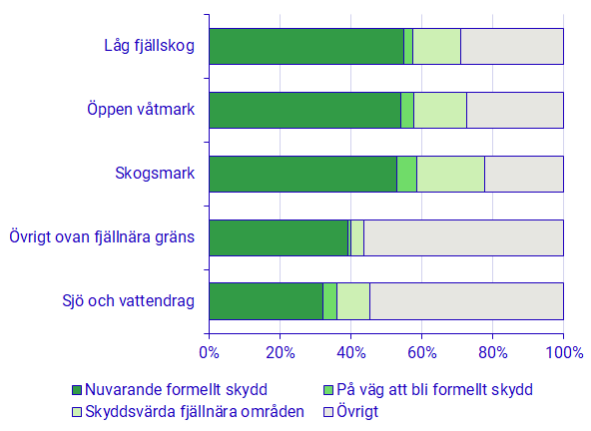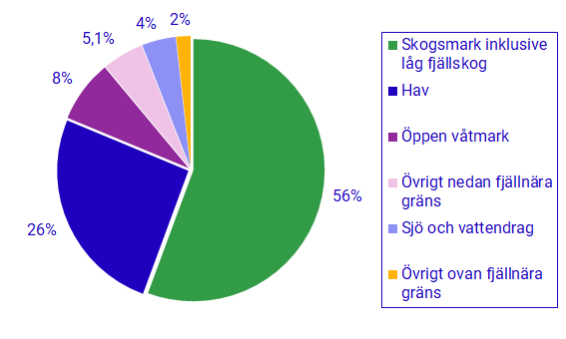Every year, the Swedish Statistical Office (SCB) and the Swedish Environmental Protection Agency publish a report on protected nature with statistics on what is protected in Sweden. The statistics cover geographically defined areas with regulations for the preservation of nature worthy of protection in accordance with the Environmental Code, as well as information on, among other things, nature conservation agreements, protected rivers, national city parks and protected species.
Of Sweden's total area, 15% is formally protected. Almost all of this area is permanently protected under the Environmental Code. This includes national parks, nature reserves, nature conservation areas, biotope protection areas, national urban parks and Natura 2000 sites.
This year's theme - reindeer grazing land and protected nature in the mountains
This year's theme in the report is about reindeer grazing land and protected nature near the mountains. On reindeer grazing land, the Sami have the legal right to use land and water for themselves and their reindeer. The land covers the whole of Norrbotten and Västerbotten counties, as well as most of both Jämtland and Västernorrland counties. The northern parts of Dalarna and Gävleborg counties are also included as reindeer grazing land.
Formally protected nature and mountain areas worthy of protection by type of nature, above the mountain border. The diagram below shows the proportion of total areas above the mountain border, 2022-12-31.

Long experience and expertise in analysis, GIS and nature conservation
Metria has contributed to the statistics on behalf of the Swedish Environmental Protection Agency, as part of a long-term collaboration in several areas. Within the framework of a cooperation agreement between the Swedish Environmental Protection Agency and Metria, Metria delivers expertise in, among other things, remote sensing and geographical information to the agency.
In the work on the statistics, Metria has collected data from various authorities, removed any overlaps between these data and then combined with different data in a GIS analysis. Data from the Nature Conservation Register and National Land Cover Data (NMD) are important in the analysis and are used, among other things, to locate which habitat types are protected. NMD is also used to monitor how much of the forest land in Sweden is protected.
The Nature Conservation Register is a national register in which the Swedish Environmental Protection Agency registers the areas protected by various laws.
- We have worked for a long time with GIS and data analysis, which has been an advantage for us in carrying out this assignment. Great experience and knowledge of how protection forms and NMD have been developed and valued has been valuable. We know where the data is located as we often work with government data that deals with protected nature and therefore know how to use it correctly, says Caisa Adolfsson, GIS and remote sensing consultant at Metria.
Increase in nature reserves in 2022 by almost 28,000 hectares
In 2022, the net increase in formally protected nature was almost 28,000 hectares. The increase in nature reserves is dominated by two new areas in Västerbotten and Norrbotten counties: Södra Gardfjället and Jielkká-Rijmagåbbå. The area also consists of large areas of mountain heath, bare rock and wetlands. One reason for preserving the area is to achieve long-term coexistence between outdoor recreation, experience values, biodiversity and reindeer husbandry.
Forest land in the majority of new areas
A total of 98 new nature reserves were created in 2022, large parts of which were already protected as Natura 2000 sites. Therefore, the net increase of new areas is only 22,000 hectares, when overlapping areas are excluded. More than half of that area is forest land including low mountain forest. Just over a quarter is marine wetland and 8% is open wetland.
Newly protected nature by type of nature in 2022
The diagram below shows the proportion of each type of nature within the new protected areas.

Read Statistics Sweden's news: Two areas dominate among new nature reserves



